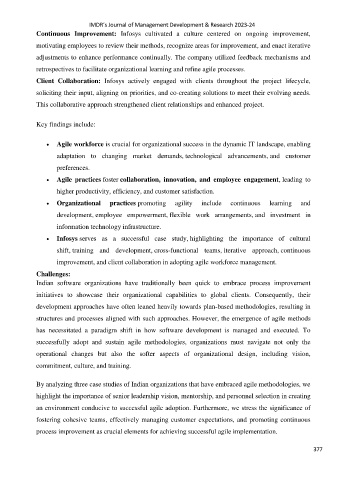Page 385 - IMDR JOURNAL 2023-24
P. 385
IMDR’s Journal of Management Development & Research 2023-24
Continuous Improvement: Infosys cultivated a culture centered on ongoing improvement,
motivating employees to review their methods, recognize areas for improvement, and enact iterative
adjustments to enhance performance continually. The company utilized feedback mechanisms and
retrospectives to facilitate organizational learning and refine agile processes.
Client Collaboration: Infosys actively engaged with clients throughout the project lifecycle,
soliciting their input, aligning on priorities, and co-creating solutions to meet their evolving needs.
This collaborative approach strengthened client relationships and enhanced project.
Key findings include:
Agile workforce is crucial for organizational success in the dynamic IT landscape, enabling
adaptation to changing market demands, technological advancements, and customer
preferences.
Agile practices foster collaboration, innovation, and employee engagement, leading to
higher productivity, efficiency, and customer satisfaction.
Organizational practices promoting agility include continuous learning and
development, employee empowerment, flexible work arrangements, and investment in
information technology infrastructure.
Infosys serves as a successful case study, highlighting the importance of cultural
shift, training and development, cross-functional teams, iterative approach, continuous
improvement, and client collaboration in adopting agile workforce management.
Challenges:
Indian software organizations have traditionally been quick to embrace process improvement
initiatives to showcase their organizational capabilities to global clients. Consequently, their
development approaches have often leaned heavily towards plan-based methodologies, resulting in
structures and processes aligned with such approaches. However, the emergence of agile methods
has necessitated a paradigm shift in how software development is managed and executed. To
successfully adopt and sustain agile methodologies, organizations must navigate not only the
operational changes but also the softer aspects of organizational design, including vision,
commitment, culture, and training.
By analyzing three case studies of Indian organizations that have embraced agile methodologies, we
highlight the importance of senior leadership vision, mentorship, and personnel selection in creating
an environment conducive to successful agile adoption. Furthermore, we stress the significance of
fostering cohesive teams, effectively managing customer expectations, and promoting continuous
process improvement as crucial elements for achieving successful agile implementation.
377

